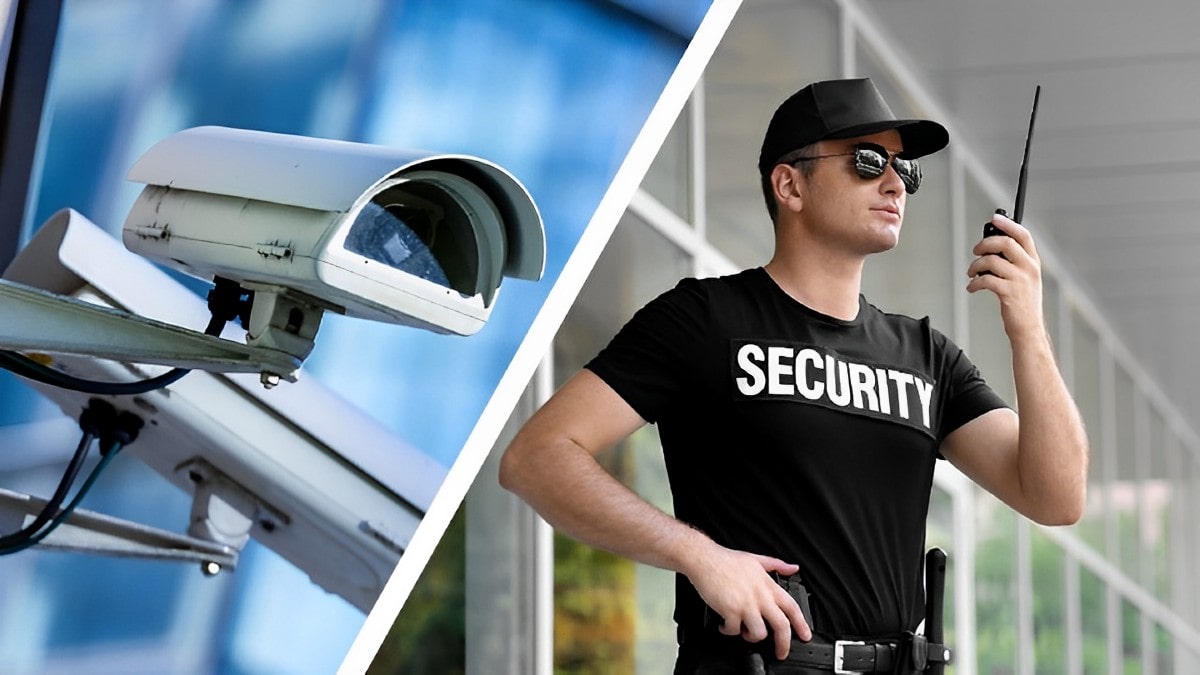It isn’t that long ago that such a choice wouldn’t even be a consideration. However, it is a testament to the rapid development of technology that remote monitoring is now a viable alternative to security guards.
Improved hardware, the integration of AI, cloud computing, and IoT, have all combined to greatly enhance the capabilities of remote monitoring security solutions.

But in this new age, is the human touch still required? That’s what we set out to explore as we look at the pros and cons of security guards vs. remote monitoring.
Security Guards vs. Remote Monitoring: The historical context.
Security guards, in various forms, have been safeguarding our assets for millennia. For most of this period, they were the sole reliable solution for comprehensive security. Even with the advent of CCTV and access control systems, these technologies were viewed as aids to enhance the efficiency of “human security” rather than direct replacements.
Today, the narrative has shifted. Advancements in hardware, the capability for remote access, and the integration of AI analytics have not only elevated remote monitoring but also posed the question of whether humans can be entirely replaced in the security domain.
However, every coin has two sides. Let’s delve into the pros and cons of both remote monitoring and security guards to determine the most robust security solution.
The advantages of security guards.
Security guards have always been an essential component of any comprehensive security strategy. Their presence offers several unique advantages:
- Human intuition: Guards can read situations and make judgment calls based on experience and instinct.
- Immediate physical response: In the event of a security breach, guards can take immediate action, ensuring rapid response times.
- Visible deterrent: The mere presence of a security guard can deter potential criminals, reducing the risk of incidents.
- Human interaction: Guards can communicate with employees, visitors, and others, providing a personal touch that technology can’t replicate.
- Versatility: Security guards can perform multiple roles, from access control to crowd management, making them a versatile asset.
The age of AI may be upon us, but the list of advantages that physical security guards bring to the table is still formidable. So, it may not be time for security guards to hang their hats up yet. However, there are distinct disadvantages to consider as well.
The disadvantages of security guards.
While security guards offer numerous benefits, it’s essential to consider the potential drawbacks associated with relying solely on human personnel for security:
- Human limitations: Guards require breaks, can’t monitor multiple places simultaneously, and may have lapses in attention or judgment.
- Cost implications: Employing security guards involves salaries, benefits, training, and potential liability costs.
- Consistency: Different guards may have varying levels of training or experience, leading to inconsistencies in security enforcement.
- Potential for error: Human errors, whether from misjudgment or oversight, can lead to security breaches.
- Vetting: Each guard must be vetted and criminal record checks conducted.
- Dependence on physical presence: Guards can only be in one place at a time, limiting their coverage area.
While security guards have been the cornerstone of security for years, these disadvantages highlight the importance of integrating technology and human personnel for a more comprehensive security approach.
The advantages of remote monitoring.
Today’s remote monitoring capabilities existed only in the realm of science fiction a few short years ago. AI is revolutionizing everything from customer support to artwork creation, including how we secure our assets.
Now, with AI, automated access control systems, and advanced surveillance, it is entirely possible to police assets without human intervention.
There are some major advantages to this:
- 24/7 surveillance: Remote systems can monitor continuously without breaks, ensuring round-the-clock security.
- Cost-effective: Once set up, remote monitoring can cover vast areas without the recurring costs of salaries or benefits. For example, compare the ongoing costs of human security services against a one-off access control systems cost.
- Advanced analytics: With AI integration, remote systems can detect unusual activities, analyze patterns, and even predict potential security threats.
- Scalability: Expanding the coverage area or adding more components is often simpler and more cost-effective than hiring additional personnel.
- Integration with access control systems: Remote monitoring can seamlessly work alongside access control mechanisms, providing a comprehensive security solution that regulates both surveillance and access.
- Real-time alerts: Modern systems can instantly notify security personnel or authorities of any breaches, ensuring swift action.
Remote monitoring is undoubtedly a powerful tool, but there are limitations as we discuss next.
The limitations of remote monitoring.
While remote monitoring offers groundbreaking advantages, it’s not without its challenges:
- Technical glitches: Systems can malfunction or face connectivity issues, leading to security gaps.
- Lack of physical Presence: Remote systems can’t provide immediate on-site intervention during breaches.
- Privacy concerns: Continuous surveillance can raise questions about privacy and data protection.
- Dependency on power: Power outages can render systems inactive, compromising security.
It’s essential to weigh these limitations against the benefits of remote monitoring, many of these drawbacks will need to be addressed if remote monitoring is ever to entirely replace security guards.
Security Guards vs. Remote Monitoring: A delicate balancing act.
The human touch that security guards offer is not yet consigned to history. While the technology that powers remote monitoring is incredible, the age of “Robo-Security-Guard” is not yet upon us.
What can be determined though, is that both approaches are improved when they are used in tandem. Integrating the intuition and judgment of human guards with the continuous surveillance and advanced analytics of remote monitoring creates a comprehensive security solution that is greater than the sum of its parts.
Leave a Reply